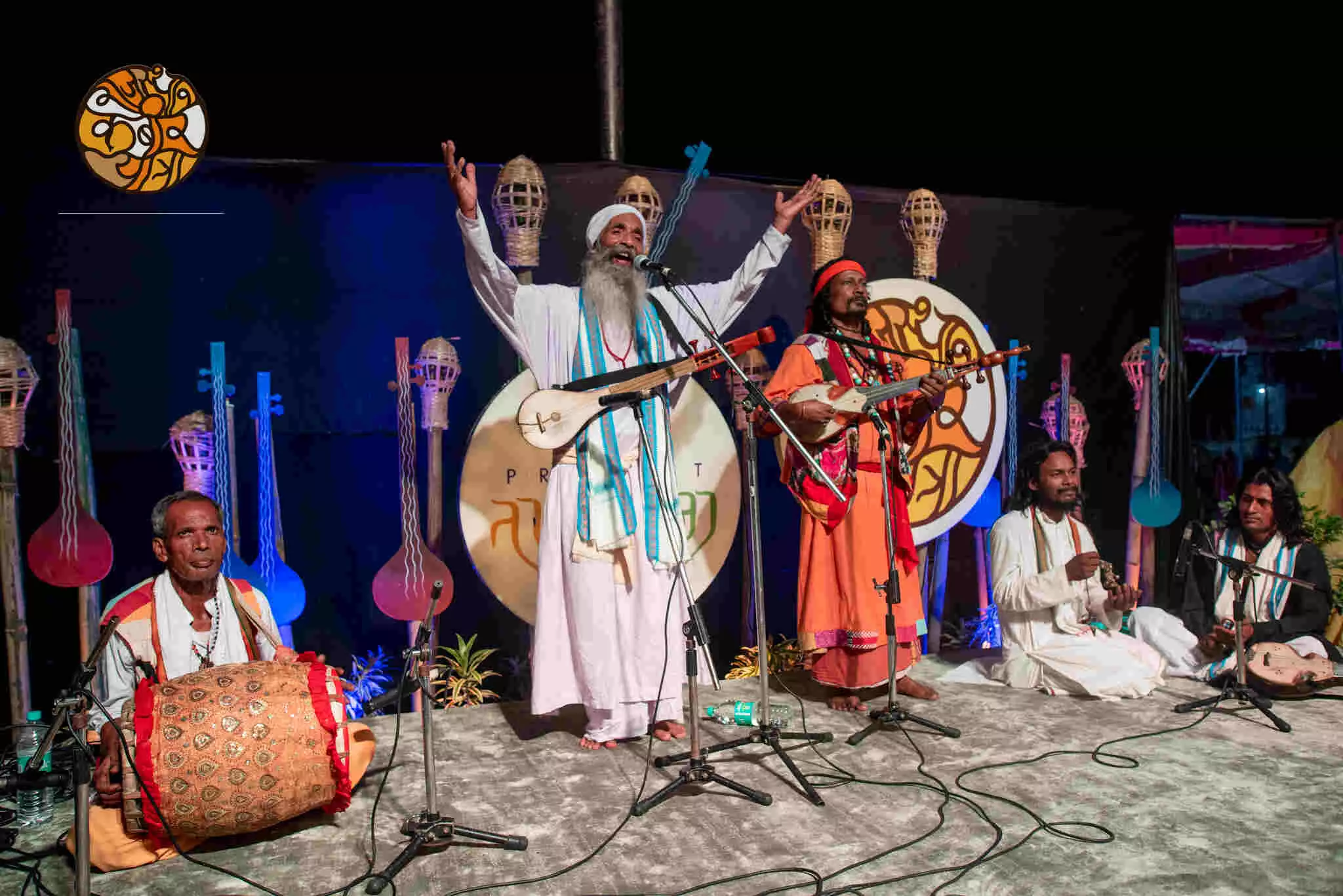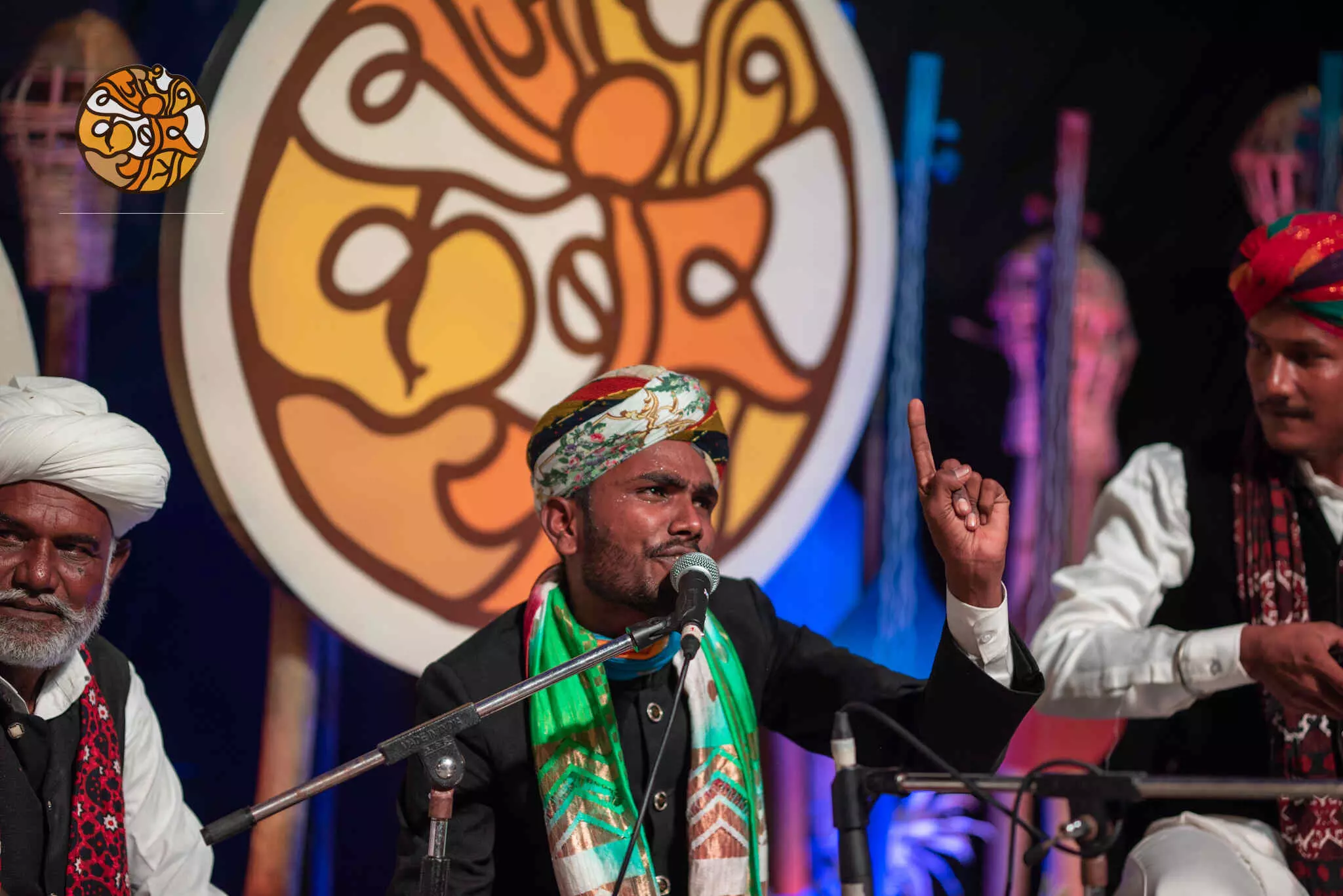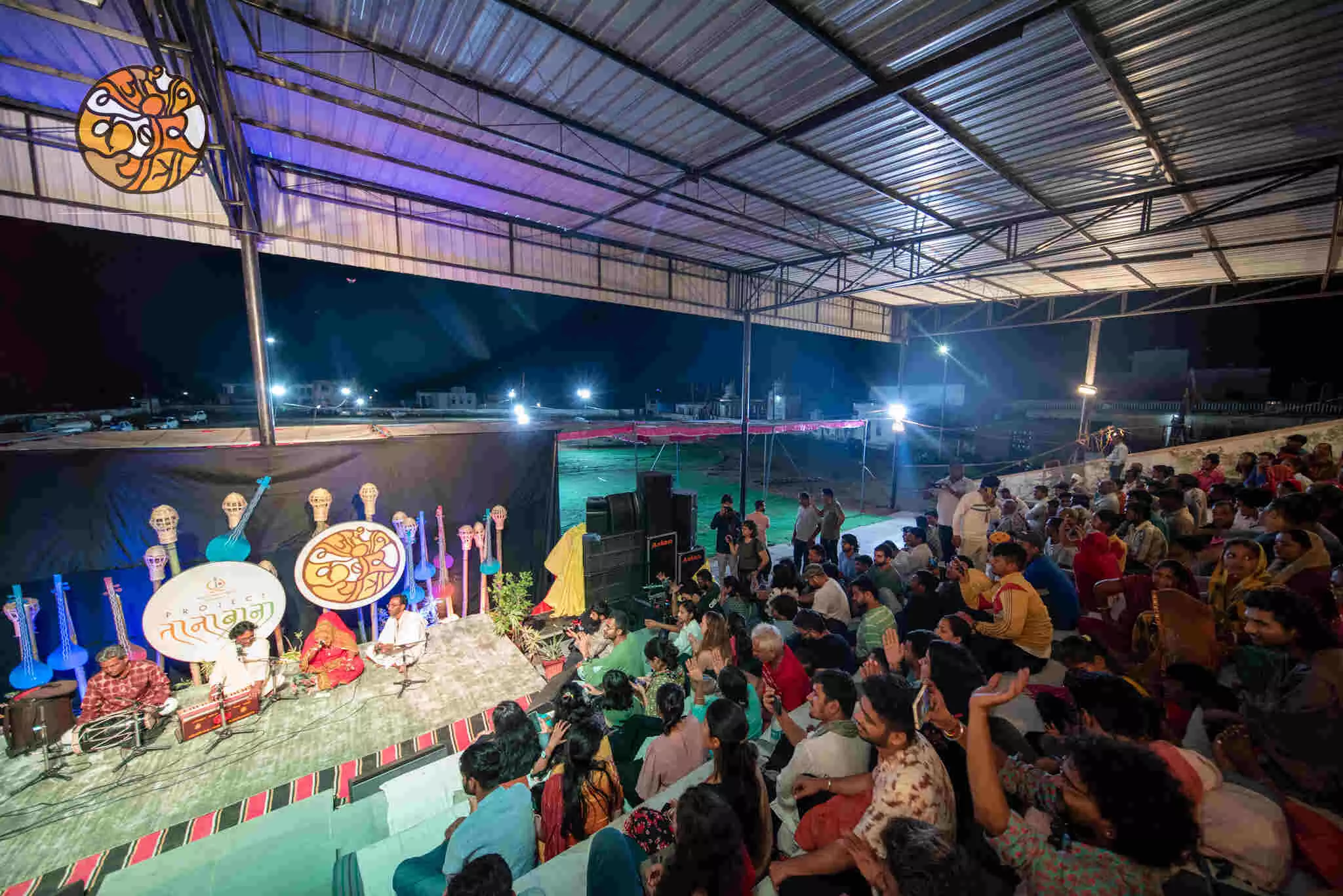Udaipur, Rajasthan
Hundreds of yatris descended on six villages falling in the two districts of Udaipur and Rajsamand in Rajasthan. They were there for the Rajasthan Kabir Yatra, 2022 that would cover hundreds of kilometres over nine days days.
Music aficionados, activists, artists, philosophers and modern day minstrels and bards who sang the songs of saint poets such as Kabir, Bulleh Shah, Meera Bai and more, made it an unforgettable event. “I prefer to call it a pilgrimage, not an event,” smiled Gopal Singh Chouhan, founder and secretary of Lokayan Sansthan, who had moved heaven and earth for several months to organise the Yatra.
Lokayan Sansthan is a public charitable society, based in Bikaner, that is committed to the documentation revival, restoration and renewal of the intangible and tangible heritage of Rajasthan.
After the launch of the Rajasthan Kabir Yatra 2022 in Udaipur attended by the who’s who of the city and the Rajasthan police who are an intrinsic part of the event, the yatris left for Kotda, a village in Udaipur district. It lies off the NH 76 A and the drive is a beautiful one, with lush undulating hills, inset with sparkling lakes and streams.
The Kotda nivasis, both Hindus and Muslims, gathered in strength to welcome the yatris with a shower of marigold petals and handed out crisp apples as a snack and water. The yatris were from all faiths, worshipped different gods but most importantly just believed in the power of love. Kabir’s song, Mo ko kahan dhoonde re bande, main to tere paas… na mandir mein, na masjid mein, na kaabe kailash mein… suddenly made so much sense.
Also Read: A Journey With Kabir: Bhakti music enthrals ‘pilgrims’ of the Rajasthan Kabir Yatra

The stalwarts of the folk traditions followed the local artistes, the men all in colourful turbans.
Fostering peace and communal harmony
While Rajasthan Kabir Yatra began in 2012, the event gathered strength in 2016 when the Rajasthan Police first partnered it to foster communal harmony through its Project Taana Baana.
“The fact that the Rajasthan police can join hands with Lokayan Sansthan to pull off such a miracle, shows that this land of Kabir, Andal, Lalded, Hijam Anganghal… has hidden springs of strength that will bring us back to love and compassion, sooner than later,” Sehjo Singh, a 59-year-old yatri and a filmmaker, entrepreneur and activist from Delhi, told Gaon Connection.
The evenings began with bhajans from the mandalis of the respective villages where the yatra travelled, and that set the mood for what was to follow.
“It was important for the people of the area to feel a part of the event. That is one of the main intentions of Project Taana Baana, to be inclusive, build bridges and foster trust and friendship,” senior police officer Amandeep Singh Kapoor, told Gaon Connection. He is Director, Central Detective Training Institute, Jaipur, that functions under the Bureau of Police Research and Development, Ministry of Home Affairs, New Delhi.

Almost every performer referred to the pointlessness of the spreading poison of hatred, communalism, war and destruction in the world.
The stalwarts of the folk traditions followed the local artistes, the men all in colourful turbans. Kaluram Bamaniya sang the soul stirring Man Mast Hua Dil Kya Bole, that was sung many many times during the yatra, Sumitra Das Goswami unleashed a powerful rendition of Chalti Chakki Dekh Kar Kabira Roye, and followed that up with a Meera bhajan.
Goswami is from Jaitaran, Pali from the Kamad community of wandering minstrels. “Women are not allowed to sing in public in the community. But, I learnt the songs from my father and with his encouragement I began to sing in the face of so much opposition and slander,” the singer told Gaon Connection. She has since sung across the globe.
Muralala Marwada, a colourful Sufi folk singer from Kutch, with his flamboyant moustache played the crowds with Duma Dum Mast Kalandar… and they got up and danced wherever they were. Vedant Bharadwaj did a soulful mashup of Maithreem Bhajata composed by Paramacharya of Kanchi, Sri Chandhrashekara Saraswathi and sung by MS Subbalakshmi at the United Nations in 1966, along with the moving John Lennon song, Imagine.
Mahesha Ram Ji, Nek Mohammad Langa, Sakoora Khan, Prabhu Mallang had the gathering swaying to their songs. The spectacular Kabir Cafe with its boundlessly energetic young members performed Mat Kar Maya Ko Ahankar, Ghat Ghat, Tod Diya … and every yatri could not help but get up and dance to their music.
Each performance, each song of the poet saints, crystal clear, simple, direct and shorn of any ambiguity… sent every yatri off on an inward journey. A fellow yatri sang snatches of Bura Jo Dekhan Main Chala, Bura Naa Milya Koye (I set out to find evil in the world outside, but when I looked within myself I found no one more evil than I…).
Songs like Maati kahe Kumhar se tu kya raunde mohe, Ik din aisa aayega, main raundoongi tohe, and Chaadar Jheeni, where Kabir likens the body to a delicately woven cloth that gets soiled and frayed in life’s journey received rousing cheers… Almost every performer referred to the pointlessness of the spreading poison of hatred, communalism, war and destruction in the world today.
Homegrown and straight from the heart
The crowd was a wonderful mix of old and the young. Roshini, Santra Devi and Kela Devi childhood friends from Haryana had joined the yatra and on the long bus journeys between the various villages, they sang, begging their Gods to pick up the pen and write them a golden destiny! The three ladies taught some of their fellow passengers the bhajans and their meaning.
“I least expected what unravelled for me here. I think I sailed through COVID because something in me wanted to come to this yatra,” laughed Devanjalee Sarkar, a 43-year-old visual artist and art-based therapist from Pune. “The idea of folk music and travel through Rajasthan was irresistible, and I wanted to explore the mystical aspect of Kabir,” she told Gaon Connection.
Sarkar said she now realised what the elders meant when they urged us to just listen to santon ki vaani (the words of the saints). “I did and it opened up doorways for me. The yatra left me amazed at the profundity of the talent of the musicians and at the same time the simplicity of their being,” she said.
Each yatri took away something from the experience. Some just sat with their eyes shut and listened to the music, some discussed world politics and the futility of war. Yet others sat in silence and drew, photographed and meditated… The performances went deep into the night, sometimes till dawn.
It had rained in Phalasia village, but the welcome the yatris received there from the villagers kept them warm even as they sat on the drenched gaddis and durries. But nothing mattered when Shabnam Virmani began to sing, or Mahesha Ram Ji sang Vaari Jaaon Re.
The goosebumps continued at the Kumbalgarh Fort built in the Aravalli range in the 15th century to keep enemies at bay. But, on that evening, the musicians and the yatris made it all about love and not war as they sang Kabir who urged humankind to end differences, animosity and battle at the UNESCO World Heritage site.
Journeys within
“I wanted to view the world through Kabir and through the eyes of those other yatris who were there,” Shivani Tale, a 24-year old who had come from Timarni in district Harda in Madhya Pradesh, told Gaon Connection. Tale works with Shedo (Social Health and Education Development Organisation), a non profit. Shedo works with the youth, women and children to empower them and educate them on their constitutional rights.
“The yatra was an opportunity to move from the journey of ‘I, me, myself’ to ‘us and ours’. I will try to live the realisations and lessons I take away from here,” she said.
“The persistence of privilege, the caste system, patriarchy, corporate greed and lack of compassion make me angry…,” Sehjo Singh said. “But, I have returned from the yatra with far less angst and far more energy,” she said.
The rawness of the landscape in Kotda, Phalasia, Kumbalgarh, Salumbar, Rajsamand or Bhim, was the perfect ground for receiving the message of love and peace from Kabir. “The yatra was a perfect jugalbandhi of music, people, philosophy and nature. Bahut sundar taana baana tha,” Devanjalee said.
Yatris went back with Kabir ringing in their hearts, on their lips and in their mobile phones. Said Devanjalee as she headed back to Pune, “It was the magic potion that I needed. Man must hua hum kya bolen…”.

The evenings began with bhajans that set the mood for what was to follow.
***
Gopal Singh Chouhan, the man behind the Rajasthan Kabir Yatra, in conversation with Gaon Connection
Gaon Connection: Congratulations on yet another mesmerising Rajasthan Kabir Yatra…
Gopal Singh Chouhan: This year we took the yatra where it had not been before, to the Mewar region. And, we covered remote tribal villages which usually are not exposed to cultural programmes such as these.
It was an opportunity to shine the light on tribal villages in remote parts of the state… And, for me it has been more of a pilgrimage than anything else.
GC: What is the response of local villagers to this annual yatra?
Chouhan: Villagers hosted and interacted with the artistes and people from so many walks of life which they would otherwise not meet. We created an ambience in their villages that they will remember for a long time.
Not just them, we as organisers were delighted to learn that the tradition of Kabir and Meera Bai was alive and well in these parts. We will be archiving all our findings.
Gaon Connection: Any challenges?
There were 350 and more yatris from across our country and there were more than 30 artiste teams. Including the volunteers, there were about 450 people moving from village to village.
Logistically, we may have been over ambitious, but these are programmes we cannot conduct again and again in such remote areas. It is difficult to raise resources and manpower so often. So, when we set out, our aim was to reach out to as many people and villages as we could.
All going well, the Rajasthan Kabir Yatra will set out once again next year on October 2 as it did this year. We will broadly stick to the same format. Of course, we will tackle some of the challenges that we faced this year and set things right.
Such festivals have great potential to bring about positive change and get people thinking. And, a few hurdles and challenges should not stop us from going right ahead.

















